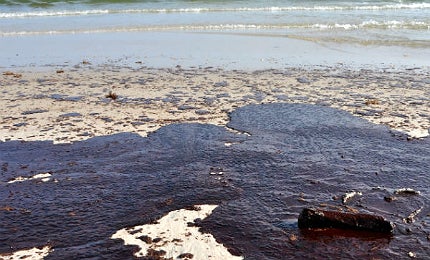

Dr Frances Metcalfe is associate director, oil and gas, at Cambridge Consultants, a provider of product development engineering and technology consulting for medical technology, industrial and consumer products, transport, energy and wireless communications industries. Dr Metcalfe leads Cambridge Consultants’ business development activities in the oil and gas sector, with a specific focus on sensing, measurement and communications.
Julian Turner: Where did the inspiration first come from to develop a fluorescent oil spill detection platform?
Frances Metcalfe: The oil and gas industry faces a number of high-value challenges that innovative technology can provide solutions for. With the recent disaster in the Gulf of Mexico, the environmental impact of oil and gas leaks has never been more visible to the public, yet the technologies currently available do not meet all the requirements in terms of performance and reliability.
As a result, offshore operators have been looking outside their traditional supply base for answers. Cambridge Consultants has been working in the oil and gas industry for a number of years in a reactive way, and this project came about after we read a DNV report on oil spill detection that looked at a number of different technologies, one of which was fluorescence detection.
We decided to focus on that because we’ve already deployed innovative breakthrough solutions in a number of different applications, including diagnostics and document authentication. We also have skills and experience outside fluorescence detection that we were confident would be of benefit to the oil and gas industry in general, and to oil spill detection in particular. We felt that if there was an opportunity to develop this technology, then we ought to be able to provide it.
How well do you really know your competitors?
Access the most comprehensive Company Profiles on the market, powered by GlobalData. Save hours of research. Gain competitive edge.

Thank you!
Your download email will arrive shortly
Not ready to buy yet? Download a free sample
We are confident about the unique quality of our Company Profiles. However, we want you to make the most beneficial decision for your business, so we offer a free sample that you can download by submitting the below form
By GlobalDataJT: Could you describe how fluorescent oil detection works?
FM: If you shine ultraviolet light onto the various different types of crude oil, you will get a fluorescent signal back – it will light up.
However, there are other things that also fluoresce and give off visible light if you illuminate them in that sort of environment – the trick is to know how you can tell the difference between what is oil and what is something you are not concerned with.
In order to appreciate the parameters of designing a sensor like this, we developed a sensing set-up that allowed us to understand the illuminating ultraviolet source, how much power we were putting in and how it’s distributed.
We also looked at the detection optics, the optical arrangement and the sensor itself – which collects the fluorescent light and puts it onto a detector – and how you filter that. From that we can understand how those signals will change if you alter the design.
We also considered what other fluorescent signals get in the way, what sort of signal they might give off and the different ways you might separate them out from the signal you are trying to measure. Another issue is sources of noise within the system that might limit the smallest amount of light you can detect.
JT: What potential benefits do fluorescence technology offer the oil and gas industry in terms of oil spill detection?
FM: Fluorescence detection is already used to locate oil leaks within pipe networks and incorporates the use of dyes alongside sensing technology. We conducted studies and experimentation into sensing technologies that detect natural fluorescence, focusing on how they might be used to monitor an oil leak in a vulnerable part of the system.
Success depends on where you want to measure the oil spill and what the confounding factors are. To be effective and trusted, any detection system must detect spills early enough but be immune to false alarms – otherwise it will not be used. We are almost certain that one detection technology on its own probably won’t provide the necessary level of robustness.
For example, an oil spill ‘alarm’ system of sensors distributed across the seabed – or a series of oil platforms – is going to need a different design solution from a system for scanning a harbour or stretch of coastline from a distance to track oil spills that might be heading for the shore.
We have a great deal of experience in combining sensing technologies, knowing which combinations will work, the signal processing and the algorithms behind those – and the sensing hardware that can give you a system that’s robust and meets the needs of any given situation. The new technology aims to provide a compact, robust system that can be permanently installed along assets such as subsea pipelines and is set to give a much-needed boost to offshore oil leak detection.
JT: The platform was based upon fertility monitor technology. Can you describe the challenges of adapting this into an oil leak early warning system?
FM: Cambridge Consultants has not only developed commercial sensors for fertility monitors, but also for clinical diagnostics equipment and pregnancy tests.
These innovations range from high-value, low-volume pieces of equipment – something you might find in a clinical laboratory – through to devices you might buy over the counter. So we’ve got a pretty good grip on how you make the trade-offs in the design in order to get the sensor you need for a specific application.
We’ve also got lots of tricks up our sleeve that we’ve used in other areas that we can draw upon in order to design an application for oil spill detection. Our world-leading skills in sensor design, data fusion and probabilistic signal processing enable us to identify and deliver the optimal solution for a given set of circumstances.
JT: What is the next step in terms of making the oil spill detection platform commercially viable?
FM: There may be a number of places on the pipe network or Christmas tree at the top of the wellhead where offshore operators think a leak is likely. We imagine installing a small network of compact, robust, inexpensive sensors around a Christmas tree or a pipe network that, along with other sensing technologies, could provide an early warning signal up to the surface.
We may not be able to address prevention of catastrophic scenarios such as Deepwater Horizon, but we imagine there are situations where it would be beneficial to know about potential leakage issues sooner rather than later, so that a decision can be made about whether or not to deploy, say, a remotely operated vehicle (ROV).
JT: Could you describe some of the other high-performance sensor developments Cambridge Consultants has undertaken for the oil and gas industry?
FM: Cambridge Consultants has undertaken sensor development for harsh subsea environments and downhole applications for the oil and gas industry using optical sensing, including fibre-optics.
We have also developed acoustic and radio frequency sensors – in addition to other electromagnetic solutions – and we also have strong background in wireless communications.
However, taking a measurement is only one part of the story; getting the information back to someone who can do something with that information is the other part.
We’re used to tackling such problems, including power, space and weight constraints – and developing products across a range of industry segments.
Related content
Oil spill response technology: potential of magnetic soaps
Magnetic soap, developed by scientists at Bristol University, is set to revolutionise oil spill clean-up operations.
Risky business: challenges of deepwater drilling in the North Sea
The UK pledged its support to oil and gas firms by introducing a £3bn tax allowance for undeveloped gas fields west of Shetland.
The North Sea’s biggest decommissioning programmes
The North Sea will witness a hike in decommissioning programmes during the next two decades as oil and gas infrastructure mature.
Sweating the assets: lifespan extension and well integrity
As the world’s demand for oil continues to grow, there is increasing pressure on producers to find new reserves and extract more from existing assets.







